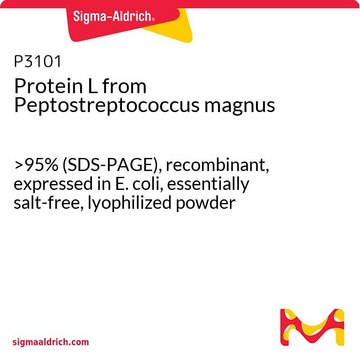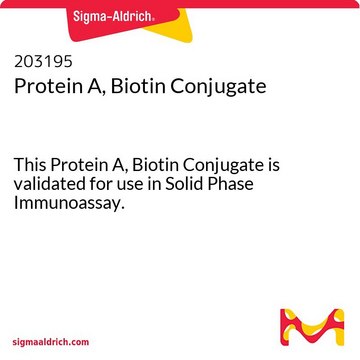P8045
Protein G-Biotin from Streptococcus sp.
recombinant, expressed in unspecified host, lyophilized powder
Synonyme(s) :
Biotinylated Protein G, Protein G Biotin, Protein G-Biotin
Se connecterpour consulter vos tarifs contractuels et ceux de votre entreprise/organisme
About This Item
Produits recommandés
Produit recombinant
expressed in unspecified host
Niveau de qualité
Conjugué
biotin conjugate
Forme
lyophilized powder
Composition
Protein, ~90% biuret
Ampleur du marquage
2-4 mol d-biotin per mol protein
Technique(s)
direct ELISA: 1:70,000 using human IgG
Température de stockage
2-8°C
Description générale
Protein G binds to antibodies reversibly and thus, it is considered in antibody purification. It is a 20 kDa protein.
Protein G is an immunoglobulin (IgG) specific bacterial cell wall protein isolated from Streptococci (group G). Native proteins G consist of two IgG-binding domains and albumin and cell surface binding sites. Biotin is a water soluble vitamin that acts as a coenzyme for carboxylase enzyme reactions. Biotin deficiency results in deregulation of metabolic pathways and various physiological impairments. Biotin deficiency is known to cause birth anomalies indicating its important role in development and differentiation of embryos.
Spécificité
Binds IgG only from most mammalian species except cat; binds chicken IgG.
Application
Protein G-Biotin from Streptococcus sp. has been used during incubation for synergistic immunocapture of antigen which was performed using streptavidin-coated magnetic beads.
Protein G-Biotin from Streptococcus sp. has been used in electrochemical biosensing, for the attachment of antibodies with different specificities.
Conditionnement
Package size based on protein content
Autres remarques
Truncated - lacks albumin, Fab and membrane binding sites.
Notes préparatoires
Prepared using biotinamidocaproate N-hydroxysuccinimide which incorporates an aminocaproyl spacer.
Clause de non-responsabilité
Unless otherwise stated in our catalog or other company documentation accompanying the product(s), our products are intended for research use only and are not to be used for any other purpose, which includes but is not limited to, unauthorized commercial uses, in vitro diagnostic uses, ex vivo or in vivo therapeutic uses or any type of consumption or application to humans or animals.
Code de la classe de stockage
11 - Combustible Solids
Classe de danger pour l'eau (WGK)
WGK 3
Point d'éclair (°F)
Not applicable
Point d'éclair (°C)
Not applicable
Équipement de protection individuelle
Eyeshields, Gloves, type N95 (US)
Faites votre choix parmi les versions les plus récentes :
Déjà en possession de ce produit ?
Retrouvez la documentation relative aux produits que vous avez récemment achetés dans la Bibliothèque de documents.
Les clients ont également consulté
Electrochemical biosensing based on universal affinity biocomposite platforms
Zacco E, et al.
Biosensors And Bioelectronics, 21(7), 1291-1301 (2006)
Ayumi Taniguchi et al.
Journal of nutritional science and vitaminology, 53(6), 457-463 (2008-01-19)
It is well known that biotin deficiency causes morphological anomalies in hatchlings of fowl. An abundance of biotin in the yolk, therefore, is greatly required for maintaining reproductive functions. Although there is growing evidence for the molecular significance of the
Principles of Bacterial Detection: Biosensors, Recognition Receptors and Microsystems: Biosensors, Recognition Receptors, and Microsystem, 21(7), 360-360 (2008)
Pierre-Henri Puech et al.
PloS one, 6(7), e22344-e22344 (2011-07-30)
The rupture forces and adhesion frequencies of single recognition complexes between an affinity selected peptide/MHC complex and a TCR at a murine hybridoma surface were measured using Atomic Force Microscopy. When the CD8 coreceptor is absent, the adhesion frequency depends
Alina Sultanova et al.
Microbiology spectrum, 10(3), e0236921-e0236921 (2022-05-24)
Human herpesvirus-6 (HHV-6) contains two genes (U12 and U51) that encode putative homologues of human G-protein-coupled receptors like CCR1, CCR3, and CCR5. It has been shown that these viral proteins can be expressed on the surface of epithelial and some
Notre équipe de scientifiques dispose d'une expérience dans tous les secteurs de la recherche, notamment en sciences de la vie, science des matériaux, synthèse chimique, chromatographie, analyse et dans de nombreux autres domaines..
Contacter notre Service technique











